Riham M. Refeat, Heba K. Louis
Safety Engineering Department, Nuclear and Radiological Regulatory Authority (NRRA), Cairo, Egypt
Correspondence to: Riham M. Refeat, Safety Engineering Department, Nuclear and Radiological Regulatory Authority (NRRA), Cairo, Egypt.
| Email: |  |
Copyright © 2016 Scientific & Academic Publishing. All Rights Reserved.
This work is licensed under the Creative Commons Attribution International License (CC BY).
http://creativecommons.org/licenses/by/4.0/

Abstract
The neutronic analysis of pressurized water reactors requires extensive knowledge of parameters that influence the reactor operation; power distributions, control rod worths, shutdown margins, and isotopic depletion rates. The ability to calculate these parameters depends on the computational models used to predict the neutron density. These models should simulate the nuclear reactor system accurately so that it operates safely and economically as designed. In the present paper, a spacer grid is modeled for a PWR fuel assembly taking into account the geometrical details. Two models are simulated using MCNPX2.7 code; 2D and the full 3D dimensions. In the 2D model the infinite and radial power distribution are calculated with and without spacer grids, to study the effects of the spacer grid. In the 3D model the effective multiplication factors and axial power distribution are calculated with and without Pyrex to study the effect of using Pyrex burnable absorber. The data used are based on VERA core physics benchmark problem. The results obtained showed a good agreement with the reference values provided for the specified benchmark problem. The results of the present paper investigated that the detailed modeling for the spacer grid leads to accurate results for both reactivity and power distribution.
Keywords:
Power distribution, Pressurized water reactor (PWR), Spacer grid and MCNPX code
Cite this paper: Riham M. Refeat, Heba K. Louis, Investigation of the Effect of Spacer Grids Modeling on Reactivity and Power Distribution in PWR Fuel Assembly, Journal of Nuclear and Particle Physics, Vol. 6 No. 3, 2016, pp. 47-52. doi: 10.5923/j.jnpp.20160603.01.
1. Introduction
Ten problems were selected in VERA Core Physics Benchmark [1] to assist nuclear software and methods developers and analysts in progressing through capabilities needed to model U.S. nuclear power reactors and their operations. The problems provide a prioritization of the VERA requirements for the virtual reactor, ranging from a simple 2D fuel pin level and progressing to full core (3D level), multi-physics, time-dependent problems. Most of the geometrical and material data is based on actual fuel and plant data from the initial core loading of Watts Bar Nuclear1 reactor (WBN1). It is a Westinghouse-designed 17x17 PWR utilizing discrete Pyrex burnable poisons (borosilicate glass, B2O3-SiO2); the assembly is comprised of fuel rods, 24 guide tubes and one instrument tube, spacer grids, and top and bottom nozzles. The main purpose of the present paper is to accurately model a 17x17 PWR fuel assembly with spacer grid using MCNPX2.7 code [2]. So particular problems were chosen from VERA core physics benchmark namely; the two-dimension (problems 2A and 2Q) and the three-dimension (problems 3A and 3B) models were simulated. More details for the calculations performed are presented in the next section.MCNPX2.7 code is used to calculate the infinite and effective multiplication factors for assembly with and without spacer grids. Moreover the radial pin power and axial power distributions are calculated. For each of the four problems, two inputs were prepared with libraries ENDF/B-VII.0 [3] (Set 1) and ENDF/B-VII.1 [4] (Set 2). The results are compared with the reference values provided for the specified benchmark problems obtained from a continuous energy Monte Carlo neutron transport solution (SCALE 6.2 Beta code KENO-VI and using ENDF/B-VII.0 cross sections).The radial and axial assembly geometry of the specified problem is presented in figures 1 and 2 and the detailed geometrical data are specified in table 1.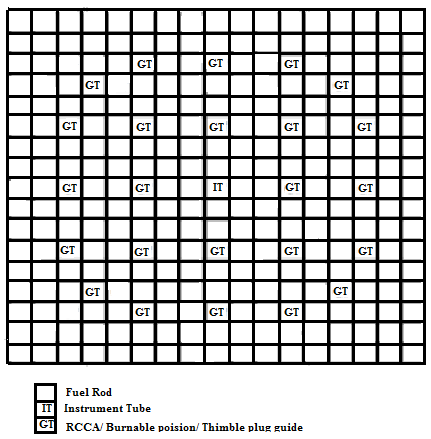 | Figure 1. Radial 17x17 Fuel Rod Assembly |
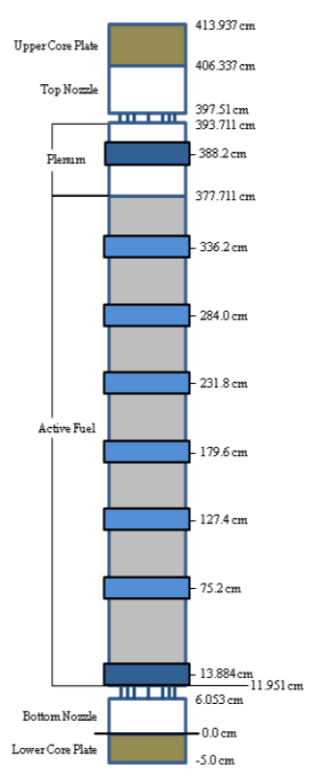 | Figure 2. Axial Assembly Geometry |
Table 1. Fuel Assembly Specification
 |
| |
|
Fuel Rod GeometryIt contains UO2 fuel stack within Zircaloy-4 cladding with an upper gas plenum, plenum spring, and upper and lower end plugs. The available rod data for fuel rod arrangement is presented in table 2.Table 2. Fuel Rod Specification
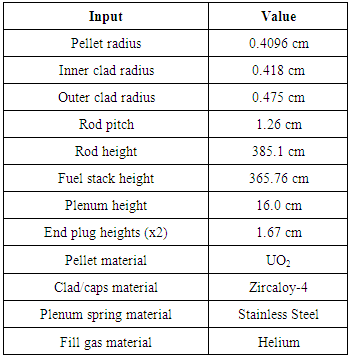 |
| |
|
Pyrex Geometry The initial WBN1 core loading utilizes Pyrex (borosilicate glass, B2O3-SiO2) discrete burnable neutron absorber located in the assembly guide tubes. The Pyrex rod arrangement is shown in figure 3 and the available rod data is presented in table 3.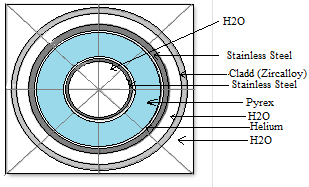 | Figure 3. Pyrex Rod Arrangement |
Table 3. Pyrex Rod Specification
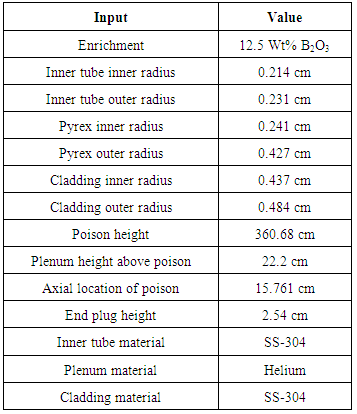 |
| |
|
Spacer GridsEach 17x17 assembly in WBN1 contains six intermediate spacer grids and two end grids which provide lateral structure support, reduction in rod vibration and bow, and in some cases coolant flow mixing. The intermediate grids are located in the active fuel region and are made of Zircaloy-4 to limit neutron absorption. However, the end grids are located at the end or outside of the fuel stack and are predominately made of Inconel for improved structural support. The available spacer grid data is presented in table 4.Table 4. Spacer Grid Specification
 |
| |
|
Table 5 presents the density of materials used in the benchmarks; it is based on the data of the initial WBN1 core. Two fuel enrichments (3.1% and 2.619%) and two moderator temperatures (565K and 600K) are used in the specified benchmark. Detailed materials specifications (Atomic densities for all the isotopes) are taken from VERA Core Physics Benchmark Progression Problem Specifications [1].Table 5. The Materials Density
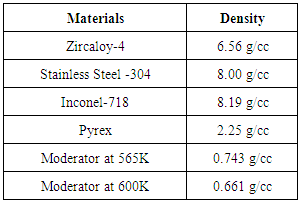 |
| |
|
2. Calculation Results and Discussion
Two-Dimensional Model CalculationsProblems 2A and 2Q in the VERA benchmark represent two-dimension calculations for 17x17 PWR assemblies. In problem 2A, the fuel enrichment is 3.1% and the moderator temperature is 565K. The assembly is specified without spacer grid and without Pyrex absorbers. Problem 2Q has the same specification as problem 2A but with Zircaloy spacer grid. The infinite and radial power distributions are calculated for the two models to study the effects from spacer grids. The results for the infinite multiplication factor for the two assemblies are shown in table 6; they are compared with the reference values provided for the specified benchmark problem [1]. The results obtained for the infinite multiplication factor using ENDF/B-VII release zero or release one are close to each other. The estimated standard deviation associated with the results is equal to 0.00018 which is an acceptable value. Table 6. The Results of Infinite Multiplication Factors
 |
| |
|
Figures 4 and 5 show the radial pin power distributions for 1/8 assembly for the two models, the assembly without grid (2A) and the assembly with grid (2Q) respectively. The results obtained using ENDF/B-VII release zero or release one are close to each other. The estimated relative error associated with the value of the maximum difference between the reference and the present results is within 0.0034. According to MCNP manual [2] this value is reliable.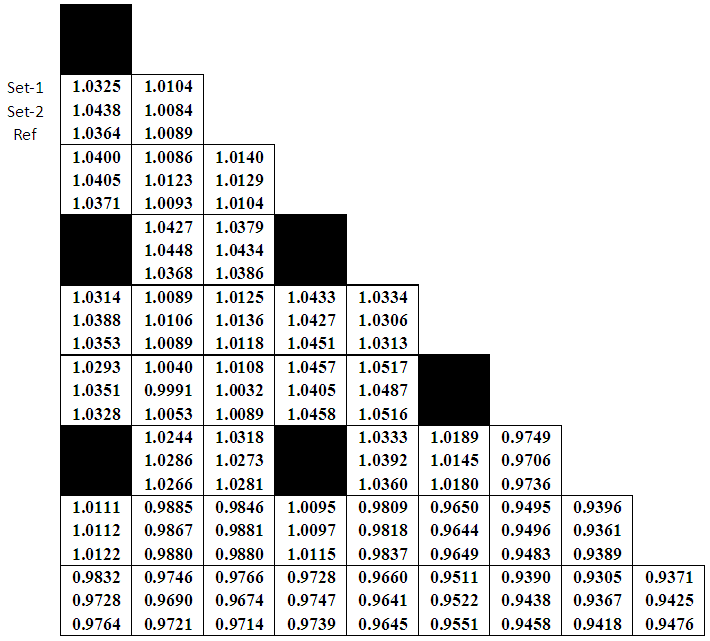 | Figure 4. The Radial Pin Power Distributions for Problem 2A |
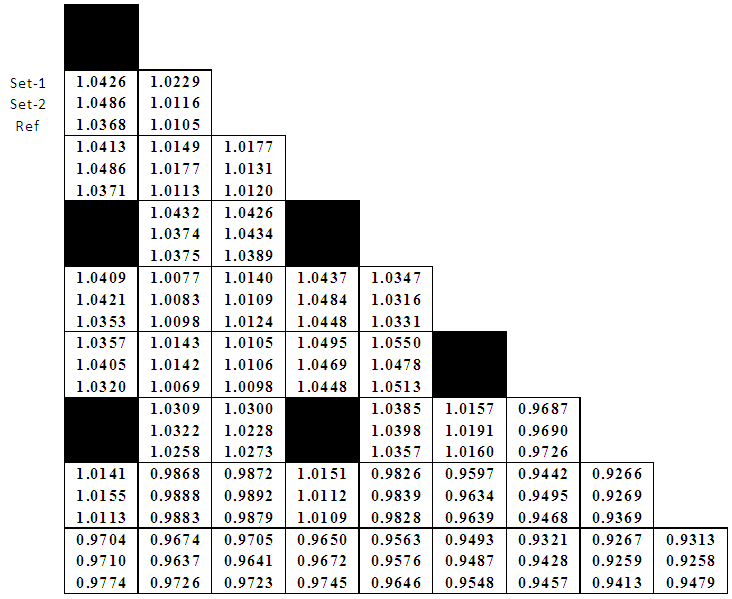 | Figure 5. The Radial Pin Power Distributions for Problem 2Q |
Three-Dimensional Model CalculationsProblems 3A and 3B in the VERA benchmark represent three-dimension calculations; each is a PWR 17x 17 assemblies, specified with six Zircaloy spacer grids and two Inconel spacer grids. In problem 3A, the fuel enrichment is 3.1%, moderator temperature is 600K and there are no Pyrex absorbers. While in problem 3B, the fuel enrichment is 2.619%, moderator temperature is 565K and there exist 16 Pyrex rods and thimble plugs in the guide tubes which do not contain Pyrex rods. The effective multiplication factors and axial power distribution are calculated for the two models to study the effect of using Pyrex burnable absorber. The results for the effective multiplication factor for the two assemblies are shown in table 7; they are compared with the reference values provided for the specified benchmark problem [1]. The results obtained using ENDF/B-VII release zero or release one are close to each other. The estimated standard deviation associated with the results is equal to 0.00018 which is an acceptable value.Table 7. The Results of Effective Multiplication Factors
 |
| |
|
The axial pin power distributions for problems 3A and 3B are shown in figures 6 and 7 respectively. The results obtained using ENDF/B-VII release zero or release one are close to each other. For case 3A, the estimated relative error associated with the value of the maximum difference between the reference and the present results is within 0.0075; this value is reliable as stated in MCNP manual [2]. Similarly for case 3B this value is within 0.0025 which is reliable too.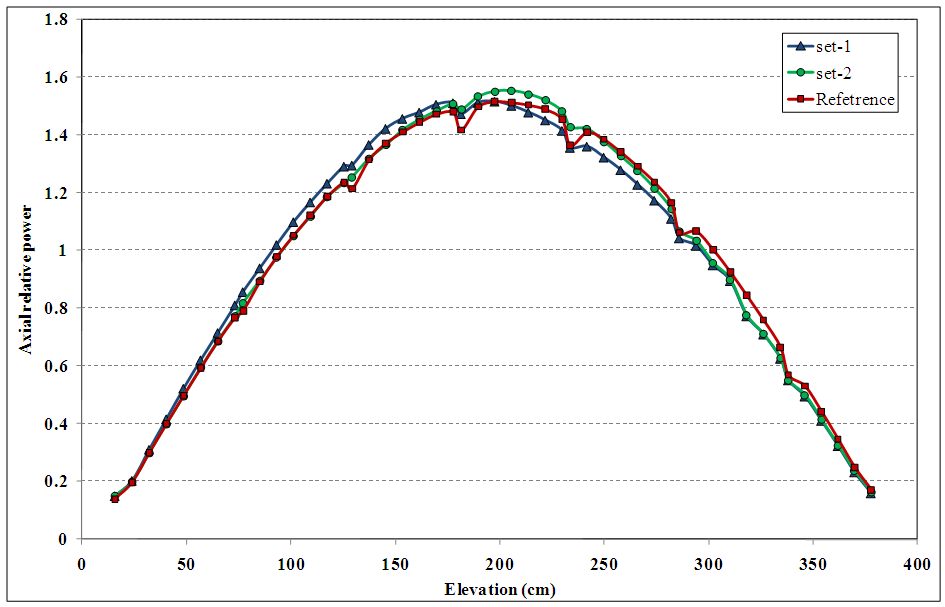 | Figure 6. The Axial Pin Power Distributions for Problem 3A |
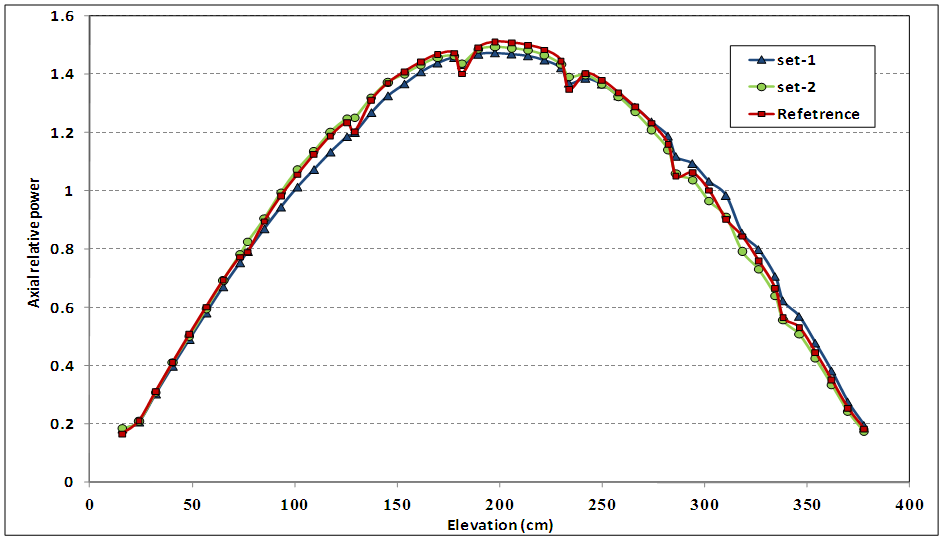 | Figure 7. The Axial Pin Power Distributions for Problem 3B |
3. Conclusions
Two models 2D and 3D dimensions are simulated for a PWR fuel assembly using the MCNPX2.7 code. The data used are based on VERA core physics benchmark problem. In the 2D model the infinite and radial power distribution are calculated with and without spacer grids, to study the effects from spacer grids. In the 3D model the effective multiplication factors and axial power distribution are calculated with and without Pyrex to study the effect of using Pyrex burnable absorber. The results obtained from MCNPX2.7 code, using ENDF/B-VII.0 and ENDF/B-VII.1 cross sections for the two-dimension problems (2A and 2Q) and three-dimension problems (3A and 3B) are in good agreement with those obtained from SCALE 6.2 Beta code KENO-VI and using ENDF/B-VII.0 cross sections. For all cases (2D and 3D dimension) the standard division and the estimated relative error associated with the value of the maximum difference between the reference and the present results is reliable as stated in MCNP manual.This showed that the detailed modeling for the spacer grid performed in this paper lead to accurate results for both reactivity and power distribution.
References
| [1] | Godfrey A. T., “VERA Core Physics Benchmark Progression Problem Specifications”, Consortium for Advanced Simulation of LWRs (CASL), Revision 4, August 29, 2014. |
| [2] | “MCNPX User's Manual. Version 2.7.0”, Los Alamos National Laboratory, LA-CP-11-00438, - 2011. |
| [3] | Chadwick M.B., et.al, "ENDF/B-VII.0: Next generation evaluated nuclear data library for nuclear science and technology", Nuclear Data Sheets 107(2006). |
| [4] | Chadwick M.B., et.al, "ENDF/B-VII.1: Nuclear Data for Science and Technology: Cross Sections, Covariances, Fission Product Yields and Decay Data", Nuclear Data Sheets 112(2011). |










 Abstract
Abstract Reference
Reference Full-Text PDF
Full-Text PDF Full-text HTML
Full-text HTML





